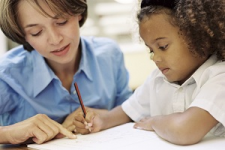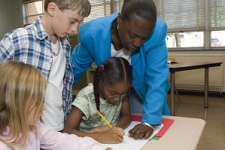How can I Enhance Learning by Teaching Students to become Curriculum Reviewers?

March 14, 2013 by PLB · Leave a Comment
Having students act as curriculum reviewers helps to really engage students at a meta-cognitive level and encourages more active involvement in learning. Writing a book review is a task that is often assigned, but how many students are asked to review the curriculum and think about what and how they are learning?
An elementary […]
What is the SLANT Strategy and How does it Improve Student Achievement?

March 14, 2013 by PLB · 3 Comments
It is important that a teacher studies a student’s body language. It helps them gauge if students are attentive, interested, and understand the lesson being taught. Sitting slouched, fidgeting and doodling are sure signs that the student is inattentive. This adversely affects the process of learning. The crux of the SLANT strategy is […]
How can I use Socratic Questioning to Support Learning in the Classroom?

March 6, 2013 by PLB · Leave a Comment
Socrates believed that using thought provoking questions could stimulate students to scrutinize ideas logically and arrive at the right answers. This idea paved the way for Socratic questioning or Dialectal approach, a technique in which the instructor feigns ignorance of the topic and assists students in learning through questioning.
The technique encourages students to […]
How can I help Students with ADHD deal with Negative Thoughts?

March 6, 2013 by PLB · Leave a Comment
Many experts study and write about the issue of self-esteem in students. Dr. John Ratey focuses in this area for students with ADHD. He writes about “ANTS” – which stands for Automated, Negative Thoughts – and claims that this is something students with ADHD often tend to develop.
These ANTS can either crush the spirit […]
How can Strategy Instruction be used to Support Learning in the Classroom?

March 1, 2013 by PLB · Leave a Comment
Research shows that students’ academic performance is enhanced when teachers implement Strategy Instruction in the classroom. Strategy Instruction involves teaching students various skills that can facilitate learning. Students are taught to choose the strategy that is best suited for the material and content that they have to learn and to make this part […]
How can Sequencing be used as a Strategy to Improve Student Learning?

February 28, 2013 by PLB · Leave a Comment
Sequencing is a strategic tool to help students develop a specific skill in the classroom and improve student learning.
The human brain tends to physically change and expand to accommodate new tasks. It continues to do this as long as the task requires new connections and newly recruited neurons. Sequenced tasks do not let […]
How can I use Chunking as an Effective Memory Strategy in the Classroom?

February 23, 2013 by PLB · Leave a Comment
Memorizing and recollecting information is a challenge in every classroom. Remembering dates, long lists of numbers and events can be taxing for some students. For students with such difficulty, learning the memory strategy “chunking” may prove very useful.
Chunking is the technique of organizing or combining individual pieces of information into “chunks.” This facilitates […]
How can I Support Twice-exceptional Students in the Classroom?

February 21, 2013 by PLB · Leave a Comment
Twice-exceptional students include gifted learners who exhibit the following indicators:
Discrepancy between verbal and performance ability.
Extremely frustrated by school.
Auditory and/or visual processing problems which may cause slow response, work delay or an appearance of thinking slowly.
Short-term or long-term memory issues.
Motor difficulties exhibited by clumsiness, poor handwriting or problems completing paper-and-pencil type tasks.
Lack of organizational […]
What is the High 5 Reading Strategy?

February 16, 2013 by PLB · Leave a Comment
The High 5 Reading Strategy is a simple and effective approach formulated to enhance the comprehensive abilities of students. By using this technique, students are able to understand the material and direct their attention to the details. It thus enhances students learning and helps them prepare for an essay or report submission or […]
What is Transference and Counter-Transference?

Transference occurs when a person we serve begins to experience unconscious feelings about us. For example, a teacher may be the recipient of transference if a child relates to the teacher as their own father or mother.
Counter-transference occurs when the teacher in turn unintentionally reciprocates with similar feelings towards the student.
Both the teacher […]



